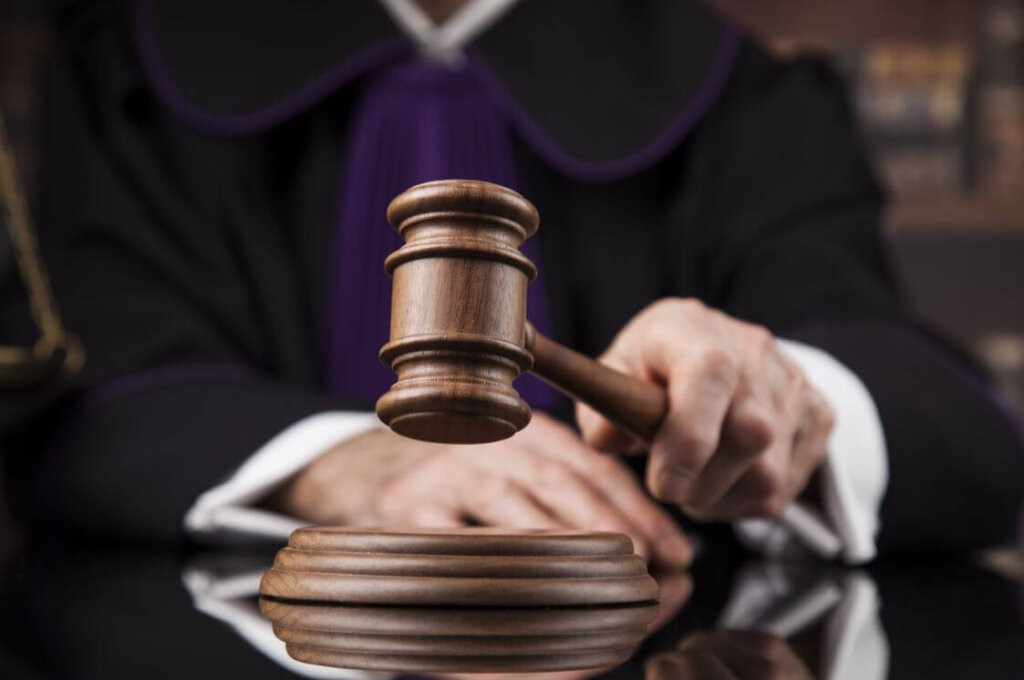As the pandemic continues to hamper regular judicial proceedings, the courts face unprecedented backlogs. In response to this and in an effort to find a viable alternative to live courtroom hearings, the Cook County Law Division in Illinois held a virtual bench hearing. Representing defendants in a civil case focused on alleged breach of contract, Kathy Ehrhart and James Boland were both part of this momentous event. Recently Ehrhart and Boland, both partners at Freeborn & Peters LLP in Chicago, spoke with Attorney at Law Magazine about their experience.
AALM: Could you share your thoughts and initial reactions about participating in this ground-breaking judicial proceeding?

KE: It was certainly exciting to be a part of what at least I understand to be the first remote civil trial proceeding in the Cook County law division. As a trial lawyer, I live for trials. But this was a whole additional layer of excitement and anticipation on top of the normal level. There was also a lot of additional anxiety. This was an entirely different type of proceeding and I was concerned about being able to provide the same level of advocacy on behalf of my clients that I do in a live setting in the remote setting. Would cross examinations feel the same? Would impeaching a witness work as well remotely? The uncertainty around how well the remote proceeding would work as well also added to my anxiety.
Like anything we do as trial lawyers, the more experience we can get doing something the better we are at it. So, I was grateful that another case provided me the opportunity to take several depositions using a remote platform just a few weeks before our trial. This gave me some additional hours logged examining witnesses in a remote proceeding to help get ready for the “big day” when our trial began.

JB: The logistics of the proceeding itself – the technology, how participants, witnesses and exhibits would be handled and who would control that process technically – was the largest issue to confront, from my perspective. That is because this would be the predicate for how all the other, more normal trial activities such as making arguments to the court, examining witnesses, lodging objections, would be approached. I think that the pandemic had prepared us all for the artifice of virtual meetings, and the limitations of that format were already known to most, if not all, participants. Beyond the format, I think that the logistics of the court’s authority over remote, non-party witnesses was one of my greatest concerns.
AALM: In preparing for this trial what aspects concerned/challenged you/your client the most?
KE: The platform itself and thinking through how to do the same things that live in the courtroom are second nature but on a remote platform might be different were the biggest concerns and challenges. How do you control a difficult witness? How do you effectively focus the witness and trier of fact on certain key aspects of a document? How do you still weave a coherent story in the defense of your case across a remote platform? All these things required consideration of whether the remote proceeding presented unique circumstances that would necessitate a different approach than I may have taken if we were in person with the trier of fact. And I did find myself as the examining lawyer using a bit more directing the trier of fact and witness through lead ins to my questions and inserting “topic headings” into my examinations. This helped ensure that I held everyone’s attention as we moved topic to topic, given we were all remote from each other and there was a greater risk of losing everyone’s attention.
AALM: We are curious about basic logistics involved in this setting. For instance, how are witnesses sworn in?
KE: The court reporter swore them in remotely over the audio/video stream. As part of our trial protocol, it was agreed that the swearing in process could happen remotely like that.
AALM: Does the court’s authority extend to witnesses who are remote and outside the court’s jurisdiction?
KE: That is an excellent question and the best response I can give is that it depends. For purposes of our trial, the trial had begun back in February and all the witnesses testifying remotely (including one that was out of state) had been previously subpoenaed for trial. The court ruled those subpoenas remained in effect for our remote proceeding. Given that, it was the court’s view that it had jurisdiction over the witnesses. It is an open question though how that might work in a different proceeding or if we did not have cooperating witnesses. The subpoena rules remain the same, however, so if a witness is out of state or unavailable, they remain so even with a remote proceeding. But if a witness is unavailable, but is “available” in that they can now readily be on a remote platform, are they still unavailable? If a witness is testifying remotely but is technically out of the court’s jurisdiction given their geographic location and a situation arises that they may be held in contempt, are they under the court’s jurisdiction? These are all open questions that we will have to see how courts choose to handle and what happens if court’s rulings on these matters are challenged.
AALM: How does one provide access to exhibits?
KE: This is an area where the parties in our case had some disagreement. The other side chose to just rely on sharing exhibits electronically with witnesses. They would screen share the document with the court, the witness, and opposing counsel and they would also offer to provide the witness control over the exhibit so the witness could electronically scan through the entire document as he or she wanted. I am a big believer, however, that the witness should always have the entire document in front of them. So our side chose to send hard copy documents to the witnesses before they testified. That provided the witness the chance to have the full document and turn to whatever page he or she needed to. In addition, we shared the document electronically using the screen sharing feature for everyone else participating in the trial to see. Both methods seemed to work fine. But again, drawing upon the remote deposition experiences I have had as well, it seems to me that more witnesses prefer to have the hard copy documents as well.
AALM: How can the court maintain itself as a public forum if the case is on a private remote platform?
KE: This was a tricky issue I think for the courts to consider as they began thinking about if remote proceedings could go forward. As you say, courts are public forums, so we needed to find a way to provide the public access to whatever platform we used for our trial. We interviewed several court reporting services who offered remote proceeding platforms and told each of them we needed for there to be a public link to the trial as well. The service we ended up using was able to provide one and the link to the trial was provided on the court’s website for a week (or more) leading up to the trial. As an attorney, it was interesting to see how many members of the public “dialed in” to our trial. We had some family members (I had my mom and an uncle from Texas) check it out. We also had several other attorneys and a couple of judges watch for a while too. I think they were interested in seeing how the remote proceeding worked, especially if it was something they were thinking about for one of their own proceedings in the future.
AALM: How does one ensure the witness is not influenced by other materials or individuals physically nearby?
KE: This is a definite concern given the witness is not in the courtroom. Each witness was instructed before they testified that they had to be alone in the room testifying and that all devices other than the computer they used to participate in the trial had to be turned off. At the start of their testimony they were provided the instruction again and asked to confirm that they were alone and had turned off all their devices. I have also participated in remote depositions where the same concerns exist and asked the witness to use the camera on his/her computer to scan the room and show they have no other individuals in the room or devices near them.
AALM: Do you think decisions/verdicts from virtual trials have a greater risk (at least at this juncture) of being challenged/overturned?
JB: It is obviously much too soon to predict, and I don’t think our trial gives us any basis to reach a conclusion. However, I think that the parties’ voluntary agreement to the procedure may be key. If the parties knowingly consent to the procedure in advance (represented by competent counsel) I would not expect that either the virtual nature of the process itself or any perceived errors resulting from that process would provide a ground for reversal. I think that a different issue may exist to the extent that court’s affirmatively order virtual proceedings (in civil cases), even over objection.
AALM: Do you think society and the judicial system in general is ready for virtual hearings/trials?
KE: Yes and no. I think a virtual trial is a band aid that can work for now to get us through the next however many months to keep moving cases forward. But remote proceedings only work well for certain cases, I think. I have a hard time picturing it working well for a jury trial. For our case, which was a bench trial, it worked. I think it helped that we had already had a few days of trial back in February, so the judge already had some familiarity with the key issues, documents, and attorneys involved. I think the judge has to be attentive, patient, and willing to try something that for most of us is very brand new. And everyone involved has to be a bit willing to “roll with the punches” as it is a new platform for everyone to get used to. Examining a witness is different, dealing with electronically displaying exhibits is different, objecting to questions is different, communication between counsel, the witness, opposing counsel, and the judge is all different on a remote platform. And all of it takes getting used to.
Is it doable? Absolutely, and if you want your case to move forward and this is the only option to do that given the limited courtroom space for live trials, it is something to consider. But there are definite downsides to a remote proceeding over a live one.
As a result of these different considerations, do I think remote proceedings will ever replace live in the courtroom trials? No.
JB: Not in my view, at least not for trials on the merits. The “crucible of the courtroom” is an apt phrase. From a global standpoint, a trial – and even an evidentiary hearing – is a living experience with human participants in a setting designed to allow the truth to be determined via a disciplined, adversarial proceeding conducted according to a set of rules. Judges, lawyers, witnesses and, in jury trials, jurors all interact on many different levels throughout a trial or hearing. The credibility of witnesses, weight of particular evidence and strength of argument are critical to each and every case and are evaluated in real time in the courtroom. Virtual proceedings are no substitute for that process, in my view. From a lawyer’s/advocate’s standpoint, virtual proceedings are no substitute for a live trial or hearing. As lawyers, we keenly observe all other trial participants at every moment of a case, and we assess the levels of comprehension and understanding of the fact, documents and issues. We structure our direct examinations of our own witnesses based on the setting and are similarly adaptive when it comes to cross examination – for which there is no substitute for live confrontation.










